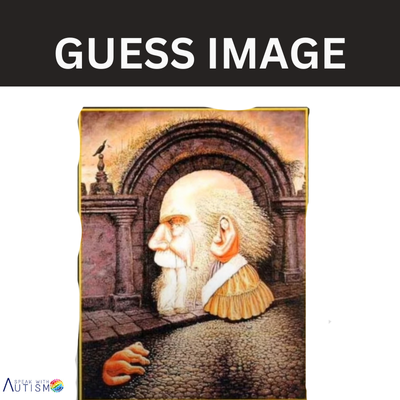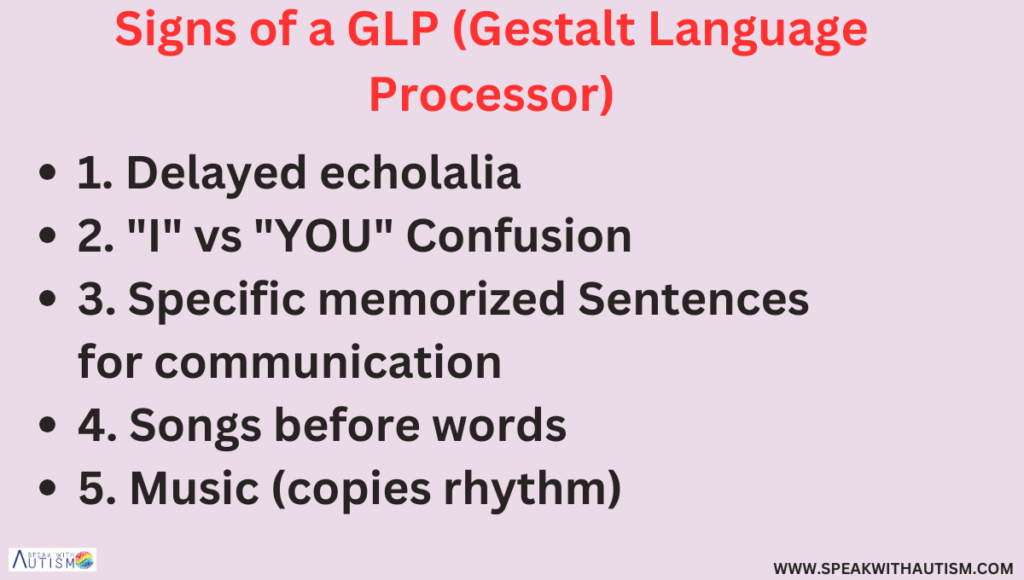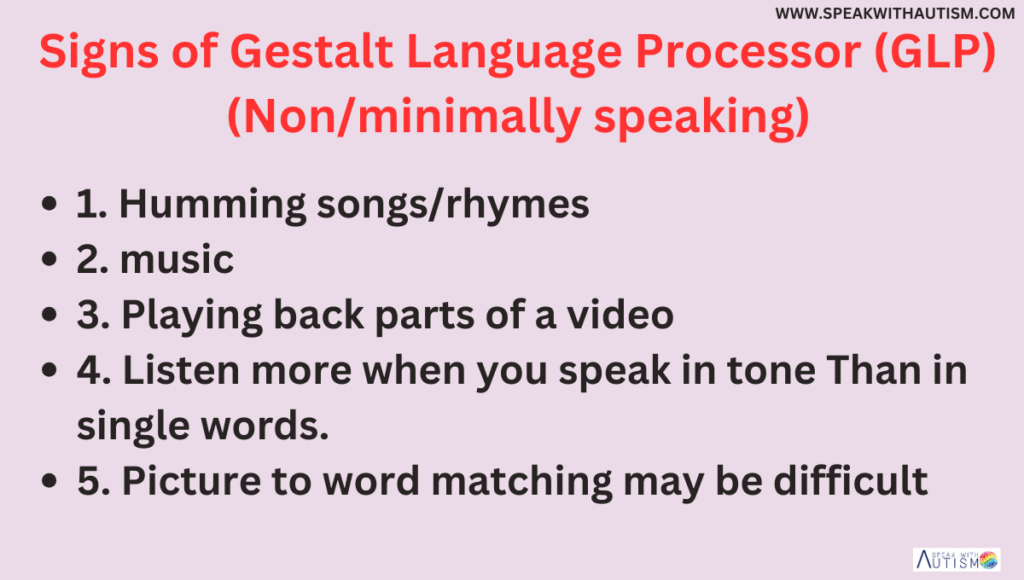Gestalt language processing is the way some children understand and use language. In this process, children memorize older phrases or sentences together and repeat them as-is, rather than understanding words separately. This is their natural way of learning language.
Table of Contents
For example, if a child memorizes the phrase “Let’s go in the park!”, he will repeat the whole sentence as a unit rather than breaking up the words into separate words (“Let’s,” “go,” “in” “the” “park”). Gradually, he learns to break up the phrases and make his own sentences.
This process is closely related to echolalia (repeating what is heard) and is common in autistic children.
Meaning and Importance of Gestalt Language processing (GLP)
Gestalt is a German word that is gu-sh-tall-t. This word has a unique meaning: “something that is made of many parts and yet is somehow more than or different from the combination of its parts.” Gestalt refers to the process of humans understanding information and the environment.


Psychology of Perception
Gestalt is a type of perception concept—in which we see something as a “whole” thing, but can interpret its different parts in different ways.
See the image and think about what comes to your mind when you look at it. I could say it’s an elephant, and we could also say it’s four faces. This shows that even though we process things as a whole, the parts of that whole can have different meanings and interpretations. They can be perceived in various ways.
In the second picture, When you see a picture, such as an image of a woman with a large and lavish dress but still understand what it is, this is an example of Gestalt Processing.
How Does the Psychology of Perception Relate to Language?
This concept can be linked to how children process language. While this is still a theory—not completely proven —it offers a perspective on how autistic children, as well as some neurotypical children, develop language. This is referred to as gestalt language processing.
Two Types of Language Processing
There are two main ways children process and develop language:
- Analytical Language Processing
- Gestalt Language Processing
Analytical Language Processing (ALP)
children first learn small words. Then they combine these words to make two or three-word sentences. Finally, they learn larger sentences and grammar. Children who are analytical processors develop language step-by-step:
- Stage 1: They first acquire many individual words, such as “Mama,” “go,” “Papa,” “play,” and “drink milk.”
- Stage 2: They combine these words into short phrases like “Mama go” or “Papa come.”
- Stage 3: These phrases evolve into full sentences, such as “Mummy, I want to drink milk” or “Let’s go to the park.”
This word-by-word method is common in many neurotypical children.
Gestalt Language Processing (GLP)
Children first memorize whole sentences or scripts. Gradually they break these sentences down into smaller parts. This approach is common in neurodivergent children, including many autistic children. Gestalt language processors follow the opposite path:
- Stage 1: They start by learning entire sentences or scripts instead of individual words. For example, if you often say, “Let’s get ready for school,” they might repeat the entire sentence, even on days when there’s no school.
- Stage 2: Over time, they begin breaking these scripts into smaller phrases. For instance, “Go to school” might become “Go to school” and “School.”
- Stage 3: Eventually, they understand individual words within the script, like “go” and “school.”
Difference between Gestalt and Analytical Language Processing

- Analytical Processors: Start small with individual words and build up to phrases and sentences.
- Gestalt Processors: Begin with whole sentences and break them down into smaller parts over time.
How to identify if your child is a Gestalt processor (GLP)?
Just like terms such as hyperlexia or stimming, gestalt processing is not a diagnostic label. Instead, it is a way to better understand your child and how they learn so that you can support them in the right way. These signs indicate that your child might be a gestalt processor.

- The first sign of a gestalt processor is delayed echolalia. You may also notice that they mix up pronouns. For instance, instead of saying “I,” they might often say “you” or “he.”
- Another characteristic is that they tend to use specific phrases for specific situations. For example, if they need help, they might always say “Help you” instead of “Help me,” “Lift me off the chair,” or “Push this away.” They stick to the same phrase rather than using variations like “Help me get up” or “I don’t need this.”
- If they want something, they might always say, “I want,” but they won’t experiment with other phrases or word combinations. This lack of flexibility in language is another indicator of gestalt processing.
- You may also notice that in their language development, they started speaking in long phrases or singing rhymes before they began communicating with single words. For example, it might be easier for them to sing the ABCs than to say individual words like “Mama,” “Papa,” “go,” or “come.”
- Gestalt processors often have a strong affinity for music. They may repeat sentences or delayed echolalic phrases more frequently if there’s rhythm or melody involved. For example, if you once said, “I can’t find my apple” in a particular tone or rhythm, they might repeat it later with the same intonation.
Non-Speaking Children as Gestalt Processors
It’s important to understand that non-speaking children or minimally speaking children (those who speak just five to ten words) can also be gestalt processors. Recognizing this can help you better support them in their communication journey.

Here are some signs that your non-speaking child might be a gestalt processor:
1. Strong Affinity for Music and Humming
- Your child hums a lot of tunes but doesn’t sing the words accurately.
- They love music and enjoy humming melodies throughout the day.
2. Repetition of Specific Jingles or Rhythmic Video Clips
They replay certain jingles or rhythmic parts of videos repeatedly, showing a strong preference for those segments.
3. Responding to Animated and Musical Communication
- They respond better when you speak with animated expressions and musical tones.
- On the other hand, if you use straightforward words like “come,” “listen,” or “sit,” it might be difficult for them to engage or connect with you.
4. Imitating Rhythmic or Pretend Play Actions
- They might try to replicate scenes from a TV show or music video, even if they don’t use words.
- They may communicate through sounds, gestures, or pretend play toys, mimicking the intonation and rhythm of the original scene.
5. Limited Response to One-Word Picture Systems
- If you’re using a picture recognition system like AAC (Augmentative and Alternative Communication) with one picture and one word, and they’re not responding well, it could indicate they are gestalt processors.
- To support them better, modify the system by adding intonations, phrases, or interesting sounds to the visuals. This could make it easier for them to respond, understand, and communicate effectively.
Understanding these signs allows you to adapt your communication approach to better suit your child’s needs.
Understanding Gestalt vs. Analytical Processing (GLP vs ALP)
It’s important to note that it is very rare for a child to be a complete gestalt processor. Think of it as a spectrum or a sliding scale:
- One end represents analytical processing.
The other end represents gestalt processing.
Most children fall somewhere in between these two extremes. For example: - A child might be predominantly a gestalt processor (e.g., 80% gestalt and 20% analytical).
Another might be equally balanced (50% gestalt and 50% analytical).
By understanding where your child lies on this spectrum, you can adapt your strategies to better support their language development.
How to help Gestalt processor children?
To support your child’s language development, the most important thing is to accept your child’s processing style. Often, we think that what they are saying doesn’t make sense, that it’s just repetition or meaningless scripting. However, if you’re thinking this way, it’s time to change your mindset.
Recognize that your child is trying to communicate. Even if their words or sentences don’t seem meaningful to you, they hold meaning for your child.
Step 1: Listen and Acknowledge
Instead of stopping echolalia or delayed scripting, tune in and listen to what your child is saying. Try to find relevance in their words.
Example:
If you show your child a picture of a birthday scene, and they start saying “cake” or “red velvet cupcake,” acknowledge it. They might not answer your specific question about the picture, but their response still holds meaning.
If they sing the “Happy Birthday” song, join in! You can act out blowing out candles and cutting the cake. Even if their response is unrelated to the picture, such as “red velvet cupcake,” understand that it may connect to their memory or experience (e.g., seeing or eating a cupcake recently).
Step 2: Use Declarative Statements, Not Questions
Children with gestalt language processing often rely on your input to learn language. How you speak to them matters.
- Avoid asking too many questions. For example, instead of asking, “What is the color of the penguin?” simply state, “The penguin is blue.”
- Speak in declarative sentences like, “I like the cake,” instead of “Do you like the cake?”
- This approach helps them learn language naturally without the pressure of answering questions.
Step 3: Practice Functional Sentences
To help your child learn communication, start by practicing simple, meaningful sentences.
- Include positive sentences: “I like cake.”
- Include negative sentences: “I don’t like this.”
- Add emotion-based sentences: “I am happy,” “I am sad,” or “I am surprised.”
- Introduce past tense sentences: “I ate cake,” “I went to the park.”
Repeat these sentences often, as repetition helps gestalt processors learn.
Step 4: Gradually Transition from Scripting to Communication
Initially, let your child script freely. Acknowledge and understand the meaning behind their scripting. Once you’ve identified the meaning, start introducing simple phrases that relate to their scripts. This gradual process helps them move from scripting to functional communication.
Overcoming Analytical Teaching Challenges
Some children may have already been exposed to analytical teaching, which focuses on one-word learning (e.g., “What is this? It’s a ball.”). This method works well for analytical processors but can cause challenges for gestalt processors, leaving them stuck at the one-word level.
For older children, shifting from analytical teaching to gestalt processing techniques can still yield significant improvements. Even if a child is 7, 9, or 12 years old, their brain remains highly adaptable. Research shows that a child’s brain is moldable up to 25 years of age.
Final Thoughts
It’s never too late to adopt strategies tailored to gestalt processing. With consistent efforts and the right approach, you can support your child’s language development and see positive changes over time.
Frequently Asked Questions
What is Gestalt Language Processing?
Gestalt language processing means that children understand language as whole sentences or scripts rather than breaking it down into individual words.
What is the Difference between Gestalt and Analytical Language Processing?
Analytical Processors: Start small with individual words and build up to phrases and sentences.
Gestalt Processors: Begin with whole sentences and break them down into smaller parts over time.
